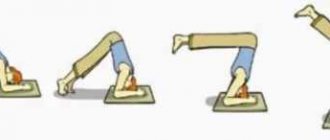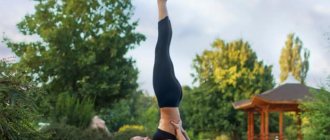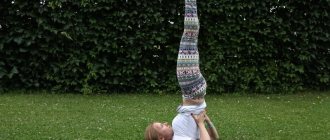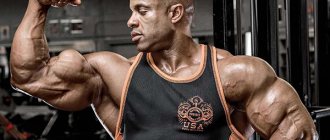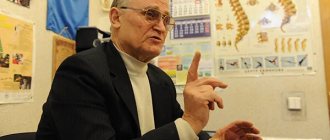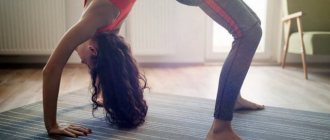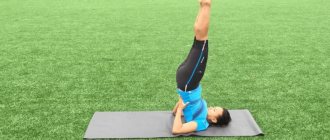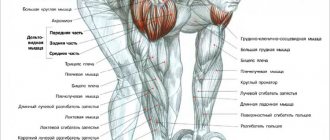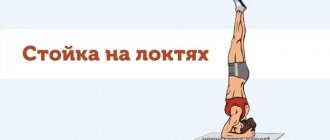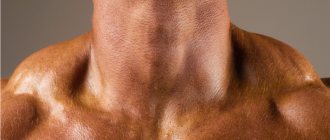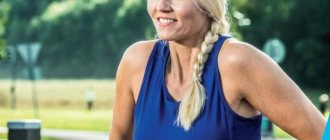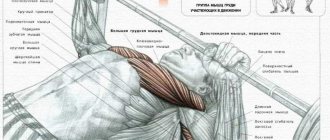I have already told you how to prepare for mastering a headstand . If you confidently perform all the exercises of the preparatory complex, it’s time to move on to the next stage.
First you need to learn how to hold corners and stands on your forearms or hands against the wall. You need to be able to hold each of these poses for at least 30 seconds and only after that you can move on to the next one. For people with neck problems - for example, hernias, osteochondrosis - handstands and forearms are generally much preferable to shirshasana.
In all inverted positions, breathing should remain free and even, without delay. Remember to stretch your back as much as possible and hold the bandhas . Inverted asanas are very dangerous, so it is better to master them under the guidance of an experienced instructor. If this is not possible, be extremely careful and remember that this is a case where it is better to underdo it than to overdo it.
Benefits of headstand
The human body is accustomed to being in a certain position. Our organs fill with blood in a certain sequence. When we turn upside down, there is greater blood flow to the brain, as a result of which the cells are rejuvenated, and the person notices an improvement in well-being.
Since headstand increases blood circulation in the brain, a person experiences improved concentration, memory, vision, and facial skin rejuvenation. The benefits of the stance are also significant for other organs, but it should only be performed by those who have previously performed other variations of it, so as not to cause harm to the body.
Due to the increased flow of blood to the pituitary gland, a person receives an enhanced effect on the development of brain cells and their activity. As a result, the benefits of headstand also affect the nervous system.
The benefits for women are also great, but during menstruation and pregnancy the asana cannot be performed. When a person performs a headstand, he notices the relaxation of the back muscles, due to which the clamps in some of its parts are released.
Let's figure out what are the benefits of Shirsasana?
This stance is one of the inverted asanas associated with hatha yoga. There are eight beneficial properties that confirm its effectiveness:
Increases the level of internal strength of the body. In the process of performing this asana, energy reserves move from top to bottom, and this allows you to rejuvenate the body. Regular use provides a positive effect on the condition of the skin and smoothes out unsightly wrinkles on all areas of the body.
There is a rush of blood to all organs, which improves the overall well-being and health of a person. This occurs due to the fact that the tissues receive increased saturation with oxygen and nutritional components.
Helps fight hair loss due to the flow of blood to the head, the process of hair growth is stimulated, and the density of its core base increases. There is a pronounced replenishment of the follicles, and the hair strands become healthier. Which helps get rid of early gray hair.
The correct level of hormones is normalized due to stimulation of the pituitary gland and hypothalamus. These glands can have a beneficial effect on the entire body. This leads to the restoration of proper functioning of the adrenal glands, thyroid and sex glands.
Getting rid of depression occurs by improving the functioning of the adrenal glands, which improves mood. All important organs work more actively and quickly cope with toxins.
This affects the emotional state, since nothing worries you, there is no pain in the body, and a high level of vigor is achieved. Because of this, this position is considered an effective remedy for combating the blues.
The heart muscle, due to the weakening of blood flow and pressure on it, gains some time to rest. This will be an excellent prevention for getting rid of heart pain or ischemic stroke.
Prevention of the development of varicose veins also comes from the previous useful side of the shirshasana stance. It reduces the level of pressure in the blood vessels and this helps reduce the risk of their expansion. The vascular tissues will not noticeably stretch and this will help avoid the appearance of various pathologies.
Improves the process of food digestion by stimulating intestinal motility, which occurs as a result of increased blood flow to this important organ of the human body. As a result, the stool becomes healthy and nothing bothers you after eating.
As a result of using the exercise, the capabilities of the body's muscles are enhanced. This occurs as a result of them straining to maintain this position correctly. Regular exercise will help strengthen all muscles, which is very beneficial for the health of the body.
But in order for you to get the maximum information about this yoga position, it is important to be aware of the possible harm from its use.
Contraindications for Shirsasana
Headstand, like some other asanas, has its own characteristics. Contraindications for performing the asana are:
- diseases of the cardiovascular system;
- epilepsy;
- traumatic brain injuries;
- high blood pressure;
- pregnancy;
- blood diseases;
- serious diseases of the spine;
- bleeding;
- kidney problems;
- otitis;
- vision problems.
The practice involves a serious load on the spine, so those who suffer from spinal column deformities, as well as osteochondrosis, scoliosis and other pathologies, should be extremely careful and perform the stance as carefully as possible. If unpleasant symptoms appear, the stand should be stopped.
Headstand technique
Shirshasana involves a smooth gradual entry into a stance. The position should only be performed by people who have already tried its lighter variations. Without preliminary preparation, performing an asana is extremely problematic and this can have a detrimental effect on a person’s health.
The technique of performing the asana requires extreme caution. To avoid damaging your spine, you need to stand with your back perfectly straight. Do not round your back or squeeze your lower back.
The headstand technique involves complete relaxation and a minimum of muscle effort. It should be done slowly and smoothly, without jerking or sudden movements. At first, it is necessary to ask someone to provide backup during a headstand or handstand, so that that person can catch their legs in time if they start to fall back.
Under no circumstances should you roll over your head, so as not to injure the cervical spine. At first, you can place your palms under your head. If there is an empty corner in the room, then you can train to perform the asana in this corner. This position will reduce the risk of capsizing. You should not lean your legs against the wall or lean on them excessively, in order to avoid the body getting used to this position in the future.
At first, it will be easier to get into the pose when swinging your leg, pushing off the floor with your other leg. In the future, the hands will get used to it and become stronger and will be able to take part in the asana, helping to keep the body in balance. Your hands should be close to your head; you cannot spread them further than 90 degrees.
Sirsasana: from vulnerability to fearlessness.
During the performance of Shirshasana, the aging process stops.
Dharma Mittra
Headstand or Shirshasana seems difficult to many people. But it is not so much difficult as it is dangerous if done incorrectly. Do not proceed to performing a headstand if you have not mastered the execution of sarvangasana (shoulder stand or “birch stand”).
If in a headstand you do not distribute the weight of your body on your arms and do not engage the muscles of your arms and upper shoulder girdle, then excess load will be placed on your neck. Although there is an opinion that most often osteochondrosis is localized in the lumbosacral spine, Professor Popelyansky Ya.Yu. claims that the prevalence of cervical osteochondrosis is not inferior to lumbar, and visits to the clinic with cervical syndromes are 11.3%, while with lumbar ones - 8.4% And although this article is about HEADSTAND, I want to especially talk about the NECK . To the neck and head we apply the “aphorism” expressed by one 4-year-old child: “Dad, of course, is in charge, but mom is dad’s master”...
The cervical vertebrae are the most vulnerable - because they are small and because they are very mobile. The desire to free his hands and raise his head to see the world from all sides allowed a person to switch to upright walking. But the phrase “raise your head” has another meaning. We hide our heads and lower our eyes when we feel insecure next to someone whom we consider better or higher than us on the hierarchical ladder, with someone whose Ego seems big and omnipotent to us. Egocentrism is one of the stages of child development that children go through at the age of 3-4 years. Having conducted projective tests with children in 2002 (we examined about 300 children’s drawings), I can say with some degree of probability that children under the age of 5 often draw their “I” so large that they cannot fit the drawing of themselves on an A4 sheet
